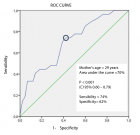Table of Contents
Navigation in the land of Scarcity
Published on: 28th December, 2018
OCLC Number/Unique Identifier: 7964862527
Delivering health care is a complex task that marginalized a portion of the population intentionally or unintentionally. Discrepancy in health care providing to the intended patients is sometimes accompanied by unintended collateral damage to the bystanders who desperately needing our help and assistance.
Severe aorto-iliac occlusive disease: Options beyond standard aorto-bifemoral bypass
Published on: 27th December, 2018
OCLC Number/Unique Identifier: 7964753024
According to recent guidelines, endovascular angioplasty is the standard treatment for TASC A and B primary aorto-iliac occlusive (AIOD) disease, and the first-line approach for TASC C lesions [1,2]. Extended TASC D occlusive disease is usually treated by open surgery yielding excellent patency rates at a cost of a higher mortality (2%-4%) and a severe morbidity (up to 10%) [3]. However, several studies have reported promising results after endovascular treatment of extensive AIOD and full reconstruction of the aortic bifurcation [4,5]. In a recent meta-analysis, Jongkind et al., concluded that endovascular treatment of extensive AIOD can be performed successfully by experienced interventionists in selected patients [6]. Although primary patency rates seem to be lower than those reported for surgical revascularization, reinterventions can often be performed percutaneously yielding a secondary patency comparable to surgical repair.
Anesthetic considerations for endovascular repair of ruptured abdominal aortic aneurysms
Published on: 11th September, 2018
OCLC Number/Unique Identifier: 7856179781
Ruptured abdominal aortic aneurysm (rAAA) carries high morbidity and mortality. Advances in endovascular techniques in the last two decades allow for minimally invasive approach for repair of these aneurysms. A succinct but comprehensive pre-operative is essential for delivery of a safe anesthetic for the patient with rAAA. Placement of proximal occlusion balloon in the descending aorta using the rapid control technique can be life-saving. Endovascular aortic repair (EVAR) can be performed under monitored anesthesia care using local anesthetic and IV sedation, and with fewer invasive lines. However, rapid conversion to general endotracheal anesthesia should be expected. Anesthesiologists should be familiar with the hemodynamic management of rAAA and be ready to provide resuscitation to correct for anemia, coagulopathy, and acidemia. In addition, the anesthesiologist should be aware of the common complications related to EVAR, including abdominal compartment syndrome, distal ischemia, and local vessel injury.
Cystic adventitial disease of the external iliac artery with disabling claudication: A case report and short review
Published on: 3rd July, 2018
OCLC Number/Unique Identifier: 7814977573
Chronic occlusive arterial disease of the periphery is primarily caused by atherosclerotic disease. In young patients with no identifi able risk factors for atherosclerosis, who present with symptoms of claudication or critical ischemia, other rare causes need to be suspected. Cystic adventitial disease is one such condition affecting young healthy patients. Although it has been reported most commonly in relation to the popliteal artery, other sites including the iliac artery can also get affected. Isolated short segment stenosis or occlusion can lead to signifi cant disabling symptoms restricted to one side. Imaging studies show pristine arterial anatomy with no evidence of systemic atherosclerotic disease and an isolated area of luminal stenosis. Defi nitive treatment involves open surgical excision with interposition grafting for optimal long-term results. We report a case of cystic adventitial disease affecting the external iliac artery in an otherwise healthy young man.
Management of Popliteal Artery aneurysms: Experience in our center
Published on: 25th January, 2018
OCLC Number/Unique Identifier: 7347025915
Background: Popliteal artery aneurysms (PAAs) are rare, but the diagnosis should not be missed because of the limb and life threatening complications. The purpose of this study was to reach a consensus about the management of PAA based on our own experience and the available literature.
Materials and Methods: This is a retrospective analysis of all patients who underwent an open surgical PAA repair at our institution from January 2015 to December 2016. Demographic data, risk factors, clinical presentation, aneurysm characteristics, type of repair and results were reviewed. Results include patency and major complications.
Results: Seven patients underwent an open surgical PAA repair (six men). Median age was 72 years. A posterior approach (PA) was chosen four times and a medial approach (MA) was chosen three times. We performed six resections with interposition of a graft and only one ligation with a bypass. Five patients recovered well, did not develop any complication and did not need a second intervention to guarantee patency. These patients underwent a resection of the aneurysm and interposition of a graft (four via a PA and one via a MA). One patient treated by resection and interposition of a Dacron graft via a MA underwent an above-the-knee amputation at postoperative day 14. This patient had a preoperatively dysfunctional leg since several months with no patent outflow vessels. Our patient treated by ligation and bypass via a MA, developed an acute ischemia four months postoperatively because of an extreme flexion of the knee during several hours while watching TV. After unsuccessful trombolysis, he underwent a femorotibial bypass and a partial forefoot amputation. No long-term results are yet available.
Conclusions: In our opinion, open surgical repair of PAAs by resection of the aneurysm and interposition of a venous graft has the best results. Depending on the relation to the knee joint and thus the accessibility of the aneurysm, a posterior approach is preferred. We are not convinced of endovascular techniques in the treatment of popliteal artery aneurysms

If you are already a member of our network and need to keep track of any developments regarding a question you have already submitted, click "take me to my Query."


















































































































































